Nova Scotia, Canada
Sphingidae Larvae
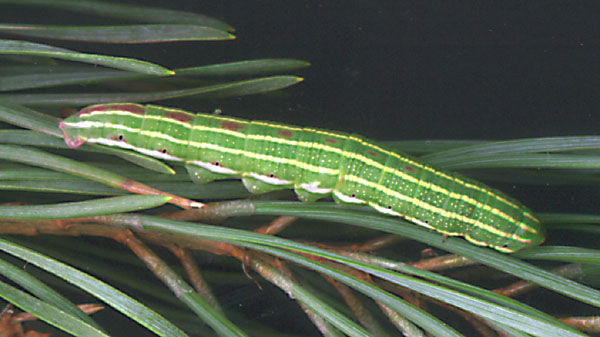
Lapara bombycoides fifth
instar larva by Bill Oehlke.
Please help me develop this list with improved, documented accuracy by sending sightings (species, date, location), preferably with an
electronic image, via email to Bill Oehlke.
This page is inspired by and dedicated to Chris Majka who provided me with some additional Sphingidae records for Nova Scotia, June 2010.
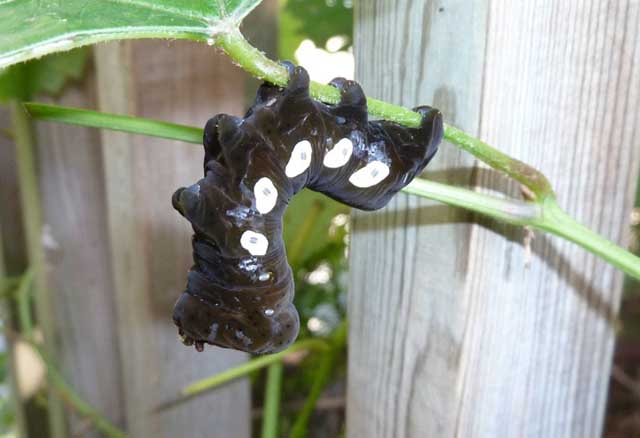
Eumorpha pandorus final instar, black form, Tatamagouche, Nova Scotia,
August 30, 2010, courtesy of Pippa, Chris and Thomas Moss.
I was surprised to see the Eumorpha pandorus larva from Tatamagouche, Nova Scotia, as I felt the sporadic reports from that province
were only of adult strays. Pippa confirms that the grape vine upon which it was feeding "is well established, being there for over two decades.
The vine it came from was in Nova Scotia even before that. We have no new vines purchased this year but did have a new honeysuckle near it,
from a local nursery.
"The pictures were taken on the 30th Aug. 2010, at about 3:45 p.m. It proceeded to eat the whole vine leaf and was still there when we left for work the
following morning, but had gone when my husband came home that night at about 8 p.m."
The date of the larva find suggest a mid to late July flight time for adult E. pandorus in Nova Scotia.
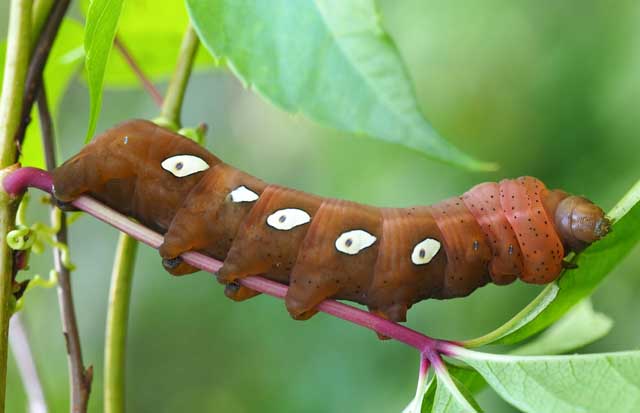
Eumorpha pandorus final instar on Virginia Creeper, Canning, Nova Scotia,
August 26, 2017, courtesy of Krista Melville.
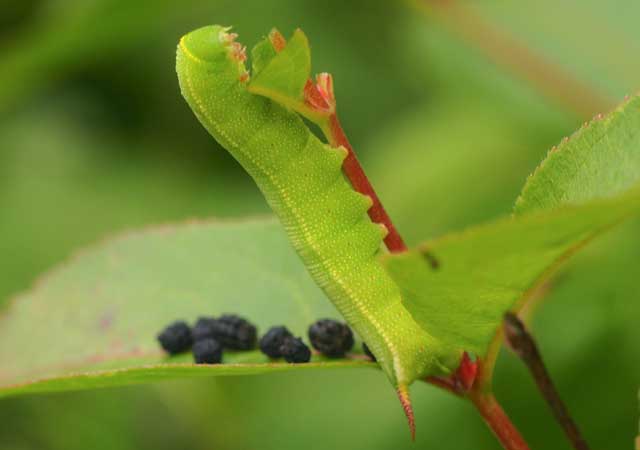
Hemaris thysbe final instar on northern bush honeysuckle,
Hammonds Plains, Nova Scotia, July 14, 2019, courtesy of Krista Melville.
The reddish anal horn in Krista's image might indicate an immature larva. I am not sure how consistent the blue horn is in fifth instar.
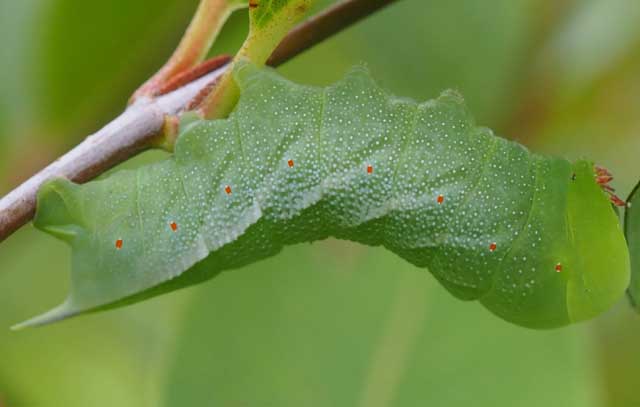
Darapsa choerilus final instar on wild raisin (Viburnum cassinoides), Hammonds Plains, Nova Scotia,
August 13, 2019, courtesy of Krista Melville.
Sphinginae subfamily
Sphingini tribe:
 |
Ceratomia amyntor
possibly just in southern N. S.,
the Elm Sphinx or Four-horned Sphinx
Larvae feed on Elm (Ulmus), birch (Betula), basswood
(Tilia), and cherry (Prunus).
There are both green and brown forms. The four horns near the head are diagnostic. |
 |
Fraxinus, Ligustrum, Quercus, Crataegus and Chionanthus virginicus are listed as hosts.
In the fifth instar, the spiracular ovals are decidedly red and the anal horn is off-white to pinkish laterally.
|
 |
Dolba hyloeus
present as an adult, Pawpaw Sphinx:
Pawpaw (Asimina triloba), littleleaf sweetfern
(Myrica aspleniifolia), possum haw (Ilex decidua),
inkberry (Ilex glabra) Tall Gallberry Holly
(Ilex coriacea). Ilex verticellata in Quebec. There is also a less common brown larva form.
I am not sure if this species breeds in Nova Scotia. Derek Bridgehouse confirms presence of adult moth, June, 2020; it might be a wind assisted stray.
|
 |
If you have pines, you probably have this species. It flies on P.E.I.
|
 |
The caterpillars are called Tomato Hornworms and each has a black horn at the end of the abdomen.
Larvae feed on potato, tobacco, tomato, and other plants in the
nightshade family (Solanaceae).
|
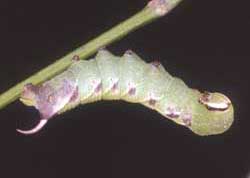
|
Sphinx canadensis present, Sphinx canadensis, the Canadian Sphinx, is not common, and is not often
reported anywhere, but it is present and is reported from southern Ontario. I believe they are present in Nova Scotia.
Larval hosts are white ash (Fraxinus americana) and blueberry (Vaccinium).
|
 |
Sphinx chersis possibly just in southern regions, the Northern Ash Sphinx or
Great Ash SphinxThis species is present and is probably common. Larval hosts are ash, lilac, privet, cherry, and quaking
aspen. Note pale blue horn.
|
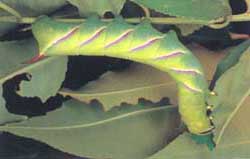 |
This species is officially reported in Ontario. We have them on P.E.I., but I do not see them nearly as frequently as I see the other Sphingidae.
|
 |
The lower forewings are predominantly brownish-yellow with a fairly wide dark bar along the inner margin. At rest the wings hug the body,
giving the moth a long slender look. Anal horn is blue with extensive black markings in final instar.
|
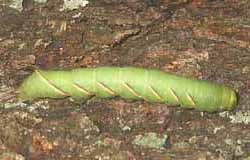 |
Sphinx luscitiosa present,
the Canadian Sphinx or Clemen's Sphinx
This one is reported from Ontario, but it is generally not common. I suspect it is in Nova Scotia.
|
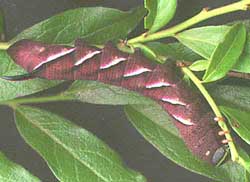 |
Sphinx poecila abundant, the Poecila Sphinx
If you have blueberries in the woods, then you might have the Poecila Sphinx.
They are pretty common here on Prince Edward Island. Larvae can be purple or green.
|
Smerinthini Tribe:
 |
Amorpha juglandis larvae feed upon Walnut and butternut (Juglans), hickory (Carya), alder (Alnus), beech (Fagus),
hazelnut (Corylus), and hop-hornbeam (Ostrya). |
 |
Pachysphinx modesta common,
the Modest Sphinx or Poplar Sphinx
Larvae feed on poplars and cottonwood.
|
 |
Larvae accept willows, birches, and cherries. I have also found them in the wild on oak in eastern Canada. generally more eastern species
|
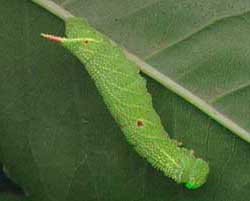 |
Paonias myops present, the Small-eyed Sphinx
Named for the small eye-spot in the hindwing, this moth has a wide distribution and is probably common in Ontario.
I regularly see them on Prince Edward Island, and they are reported as far south as Florida.
|
 |
Smerinthus cerisyi common, the Cerisyi's Sphinx
Smerinthus cerisyi is found in the southern regions of all Canadian provinces and in northern border states. The one-eyed sphinx is also
found along the U.S. west coast, eastward to the Rockies. At my home in Montague, P.E.I., Canada, they are quite common.
|
 |
Larvae feed upon many forest trees including birches and cherries, but are expecially fond of poplars and willows. Red markings on sides
vary greatly from specimen to specimen.
|
Macroglossinae subfamily
Dilophonotini tribe:
See Hemaris comparison to help distinguish
the next three species.
 |
Hemaris thysbe common, the Hummingbird Clearwing
There is also an orangey-pink prepupal form. The lateral line runs from S1 to the blue horn.
Hemaris thysbe larvae feed on viburnum and related plants. generally more eastern species
|
 |
Hemaris diffinis common, the Snowberry Clearwing or Bumblebee Moth
Larval host plants include Snowberry (Symphoricarpos), honeysuckle (Lonicera), Coralberry, viburnums, Blue Dogbane
(Apocynum) and dwarf bush honeysuckle (Diervilla lonicera). Horn is black with a yellow base.
|
 |
Hemaris gracilis present, the Slender Clearwing or Graceful Clearwing
This day-flying moth is less common.
|
Philampelini tribe:
 |
If you have Grape or Virginia Creeper nearby, then you might encounter
this species. Note the five large white ovals. There are orangey-brown and green and nearly black
forms also. |
Macroglossini tribe:
 |
In additon to Virginia creeper larvae accept Grape (Vitis), ampelopsis (Ampelopsis), and cayenne pepper (Capsicum).
Larvae are green until the final instar.
|
 |
Larvae feed on Azalea and Viburnum and progress very rapidly. The larva to the left on Viburnum cassinoides is getting ready to
pupate. Color change from green to light burgundy-brown indicates pupation is imminent. |
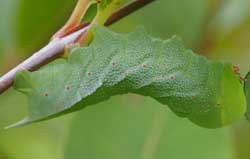 |
Larvae feed on Azalea and Viburnum and progress very rapidly. The larva to the left (green form) on Viburnum cassinoides shows the typical
patterning before turning darker brown.
|
 |
Hyles gallii present, the Bedstraw Hawk Moth or Gallium Sphinx
This species is reported in Ontario. Some years I see them on P.E.I., some years, I do not.
Larvae can be quite variable.
|
 |
Larvae are highly varied and feed on a great diversity of plants including willow weed (Epilobium), four o'clock (Mirabilis),
apple (Malus), evening primrose (Oenothera), elm (Ulmus), grape (Vitis), tomato (Lycopersicon),
purslane (Portulaca), and Fuschia.
All larvae seem, however, to have the red/black swellings split by dorso-lateral lines.
|
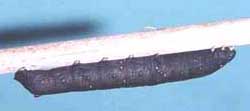 |
This day flier is officially reported from Ontario, but it maynot be common. Look for them in meadows near coniferous forests.
|
|
|
Enjoy some of nature's wonderments, giant silk moth cocoons.
These cocoons are for sale winter and fall. Beautiful Saturniidae moths will emerge the following spring and summer.
Read Actias luna rearing article.
Additional online help available.
Eggs of many North American species are offered during the spring and summer. Occasionally
summer Actias luna and summer Antheraea polyphemus cocoons are available. Shipping to US destinations is done
from with in the US.
Use your browser "Back" button to return to the previous page.
This page is brought to you by
Bill Oehlke and the
WLSS. Pages are on space rented from Bizland. If you would like to become a "Patron of the Sphingidae Site", contact Bill.
Please send sightings/images to Bill. I will do my best to respond to requests for identification help.
 | 
Show appreciation for this site by clicking on flashing butterfly to the left.
The link will take you to a page with links to many insect sites. |
This website has been created and is maintained by Bill Oehlke without government or institutional financial assistance. All expenses, ie., text reference
support material, webspace rental from Bizland, computer repairs/replacements, backups systems, software for image adjustments (Adobe Photoshop; L-View),
ftp software, anti-virus protection, scanner, etc. are my own. The one-time-life-time membership fee that is charged at the time of the
registration covers most of those expenses.
I very much appreciate all the many images that have been sent to me, or of which I have been granted permission to copy and post from other websites.
All images on this site remain the property of respective photographers.
If you would like to contribute to the maintenance of this website by sending a contribution to
Bill Oehlke
Box 476
155 Peardon Road
Montague, Prince Edward Island, C0A1R0
Canada
your donation would be much appreciated and would be used for
1) paying for webspace rental;
2) paying for computer maintenance and software upgrades;
3) purchases of additional text reference material (journals and books) in an effort to stay current with new species;
4) helping to pay my daughter's tuition (completed Spring 2013).
I also hope to expand the North American Catocala site as well as the Sphingidae of the Americas site, to worldwide sites, and that
will require additional funds for reference materials, etc. Both of those site are linked from your WLSS homepage.
If you are mailing a check from USA, please use $1.25 postage (2019 rate). Donations can also be made through Paypal via the button below.
Donations are not required to maintain your standing as a WLSS member, nor do they gain you any preferencial treatment with regard to livestock and/or
supplies (sleeves), compared to othe rWLSS members. All WLSS members get first crack at my annual offerings and get an approximate discount of 10% as
compared to non-members.
I do usually ask donors if they have any special requests for material on WLSS, and I try to accomodate when appropriate or within my ability to do so.





